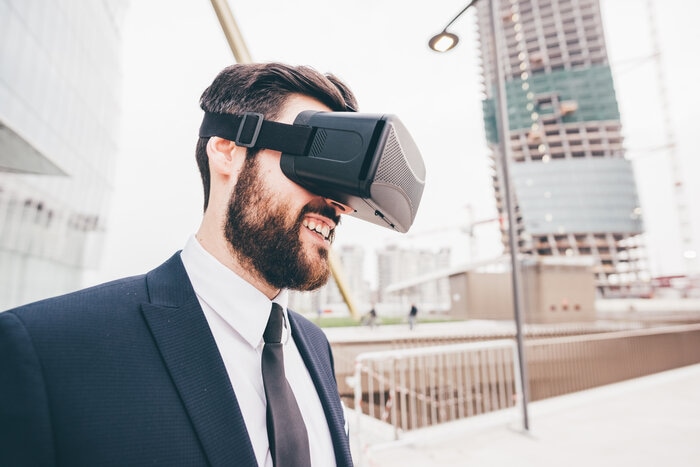Topics: metaverse, Digital Transformation
White Paper: Understanding the Metaverse and its Benefits
10 minute read
By Mayank Jain
What exactly is the metaverse?
“If dreams could be sold, what would you buy?”
A virtual world exists beyond the physical world in which humans have existed within since the beginning of time. These virtual spaces can be accessed using virtual reality headsets that bring the augmented environments into view. This virtual environment is a new place to meet people, advertise, sell products, experiment with new ideas in a safe zone. It takes the digital world another step forward.
As consumers spend more time online and the hype around the metaverse continues to cascade into virtual goods, business leaders can unlock new ways of engaging with high-value younger cohorts.
To capture untapped value streams, organizations are exploring the potential of non-fungible tokens, gaming, and virtual engagement — all of which offer fresh routes to creativity, community-building, and commerce.
The concept of a metaverse is not a new one
This is, however, a significant progression from the existing technology in many ways. Say, for example, offering sensory experiences like touch, feel, smell, etc., whereas the current technology limits only to visual and audio, and that too in a limited manner. While the buzz can partially be attributed to attention-grabbing headlines, there is a convergence of emerging technologies to serve a virtual reality.
Online multi-player, role-playing worlds like the Sims or Second Life have been around for nearly 20 years, with players spending an average of 20 hours per week in these worlds. Modern equivalents like Minecraft, World of Warcraft, and Fortnite have hundreds of millions of users and huge supporting economies.
There are more than 500 million monthly active users on the metaverse today, and it is expected to grow at a rate of 140 million new users per year.
Metaverse is better understood as a new channel of engagement
It’s hard for people who’ve lived their lives in the non-virtual world to imagine a virtual landscape with user avatars busying themselves performing activities more familiar to gamers than generations that grew up in a time when Amstrad computers were a thing. It’s difficult to visualize why it has any relevance to the real world of business we’ve lived in for generations. But it does.
The evolutionary path of the digital world can itself be traced to the path followed by websites and mobile apps a few years ago. The initial days of website deployment were not taken seriously by brick-and-mortar retailers, giving rise to a new generation of retailers like Amazon. Can we expect to see the same for augmented reality?
Metaverse is likely to follow a similar trend and we may see the emergence of torch-bearer meta-organizations for “immersive/ virtual retail” soon enough.
There is no single virtual world but many worlds, which are taking shape to enable people to deepen and extend social interactions digitally. They represent a simulated 3D land, horizon worlds, a new virtual reality.
From a social perspective, the development of more immersive virtual experiences is helping people build communities based on shared values, and express themselves in more authentic ways.
To deliver ‘authentic’, ‘realistic’, and ‘immersive’ virtual reality experiences for customers, organizations are looking to create more autonomous organizations, design more immersive experiences, and create more touch-points.

There are close to 1000 metaverses today, growing by the day
Why is it difficult to ignore the metaverse
Business leaders know the real world. They grew up in it. It’s stayed familiar, and easy enough to frame. Bold claims on the promise of the metaverse appear salacious and abstract to those who’ve never so much as owned a gaming console.
As digital environments come of age, they are transforming from linear and transaction-focused spaces into multi-dimensional, experiential, collaborative, and completely immersive virtual worlds. Tech-savvy cohorts are spending increasing amounts of time in these spaces — from social media and gaming to virtual realities — and they are adopting multiverse identities along the way.
Sub-technologies that are playing their part
At the vanguard, digital assets in the form of virtual fashion and NFTs are offering new ways for consumers to shop, exchange goods and inhabit new identities.
Hyper-interactive and creative digital environments are a natural evolution of how people use technology and reflect the ever-growing amount of time consumers spend online.
In 2020, it was estimated that Gen-Z spent an average of eight hours per day online.
Part of the appeal of virtual worlds is the chance to engage with others and build communities — a need that was exacerbated when global lockdowns put an end to most in-person social contact.
As digital spaces become more dynamic, some consumers are participating in “digital campfires,” around which they can connect with others who share their values, have conversations, tell stories, and co-create.
Digital fashion and metaverse industries
Soaring levels of engagement have spawned a new generation of digital fashion creatives, who are pushing the limits of possibility online.
Brands, meanwhile, see the emerging metaverse, in which people work, play, socialize and shop, as an opportunity to engage more deeply and creatively with their customers and unlock new value streams.
There are more and more ‘second worlds’ where one can express oneself. Metaverse is becoming a big business, with funding pouring in from investors.
“There is probably an underestimation of the value being attached to individuals who want to express themselves in a virtual world with a virtual product, through a virtual persona,” said Gucci’s chief marketing officer Robert Triefus, citing the 19 million visitors who came to the Gucci Garden within the Roblox gaming metaverse.
Epic Games raised $1 billion in April 2021 to accelerate its work in building connected social experiences across a metaverse of linked games and services.
Much of the excitement around virtual environments is directed toward NFTs, which have seen an explosion of interest over the past year. NFTs are unique crypto assets whose authenticity and ownership are verified on blockchain technology and are bought, sold, and exchanged in the metaverse, often with cryptocurrency.
Digital assets in the form of virtual fashion and NFTs are offering new ways for consumers to shop, exchange goods and inhabit new identities.
How can organizations step into virtual reality?
Your organization might wish to create a virtual world or create virtual spaces to improve its own customer, partner, and workforce experiences. You won’t be alone. It’s thought that nearly 50% of organizations are either building or thinking about building capability for metaverse within the next 2 years.
Fundamentally metaverse is offering a new playbook to organizations
Blockchain technology is offering to build autonomous and transparent organizations with new product offerings. Immersive experiences are driving gaming, social and commerce together, and the intimately collaborative environments are creating new touch-points for the customers and for the businesses.
There are multiple use cases within these business drivers that find a special value for the organizations. The burden is on the organizations to drive the right value for the cohort they serve.
We are also seeing a growing role for artificial intelligence, 3D product configurations, and visualization tools amongst other technologies to take the metaverse to a whole new level. Knowledge of these complementary technologies–in addition to data engineering and data security–is proving necessary ingredients for implementation teams wishing to develop a strategy for growth in the metaverse.
Metaverse offers a new channel of engagement, as websites did
The initial days of website deployment were not taken seriously by the brick-and-mortar retailers, and that gave rise to a new generation of retailers like eBay and Amazon. We will likely see the metaverse follow a similar trend with the emergence of “immersive retail” or “virtual retail” soon enough.
We are now at an inflection point, where it seems that not a day goes by without a company or celebrity announcing that they are building a presence in the augmented reality. While the buzz can partially be attributed to attention-grabbing headlines, there is a convergence of emerging trends.
Trends that emerged from our research:
- Nearly 50% of the organizations are either building or thinking about building capability for metaverse within the next 2-years
- The biggest business driver for metaverse adaptation is about creating immersive experiences to bring gaming, social, and commerce together, closely followed by building additional touch points for the customers.
- Building secure transaction platforms is the biggest use case for the adoption of blockchain
- Priorities for adopting virtual reality and augmented reality metaverse solutions are split amongst building immersive 3D experiences, creating a strategic vision for virtual commerce, and enriching marketing platforms
- The most popular use case for the metaverse journey BY FAR is to allow users to experience products intimately through a virtual ecosystem.
Our research provides a clear view in terms of how relevant it has become for organizations to adopt and find the right value model for the right cohort.
While conglomerates like Amazon are already building metaverse capabilities, we will see the emergence of new product categories and new business models – for the new customer.

The shift from “brand loyalty” to “experience loyalty” is silent, but swift. Merging of the digital and physical is happening at an unprecedented rate.
Conclusion
Metaverse provides a powerful platform for the industry in driving commerce with “see-now-buy-now” initiatives through customized virtual and AR experiences.
With this new technology, digital products are transformed into 3D objects that demonstrate details, texture, and construction in a more immersive experience.
The metaverse is now being used by iconic brands such as BMW, Salvatore Ferragamo, Giorgio Armani, Victoria’s Secret, Volkswagen, Unilever, Walmart, Hugo Boss, and many more to develop virtual assets and environments to showcase their products.
Metaverse platforms are expected to excel in their ability to engage with younger cohorts of consumers.
The shift from “brand loyalty” to “experience loyalty” is silent, but swift. Merging of the digital and physical is happening at an unprecedented rate.
McKinsey predicts the metaverse to have $5 trillion worth of impact on the economy by 2030. Perhaps technology adoption will once again define the leaders from laggards!
For many firms, their first step is to ‘tool up’ on sub-technologies.
What we can learn from the rapid expansion of AI over the past decade is that the democratization of development tools and skills will be essential to fuel growth. In the case of the metaverse, we are seeing ‘sub-technologies’ like NFTs, blockchain, 3D, AR/VR, etc. gather pace. This is likely to be a signpost to business leaders that an era of virtual worlds is upon us.
Author
Mayank Jain is Chief Metaverse Officer and Head of Digital Services at USTech Solutions. He has over 20 years of experience in helping organizations transform through technology and innovation. Mayank is a Digital Transformation evangelist and has created several cutting-edge capabilities. Mayank currently leads the Metaverse and Digital capabilities for USTech Solutions.
Related articles
A quick guide to fertility benefits in the workplace
Recent studies show offering fertility benefits to employees could bring great competitive advantages. Here’s what companies should know.
Co-Innovation and the Gig Economy
We examine the role co-innovation will play in the future of the gig economy, specifically for the engagement of freelance tech talent.
The hybrid work bias and how it affects women
Proximity bias is shown to have a strong impact on hybrid workers, especially women. What strategies can organisations employ to mitigate it?
A quick guide to fertility benefits in the workplace
Recent studies show offering fertility benefits to employees could bring great competitive advantages. Here’s what companies should know.


Recent Comments